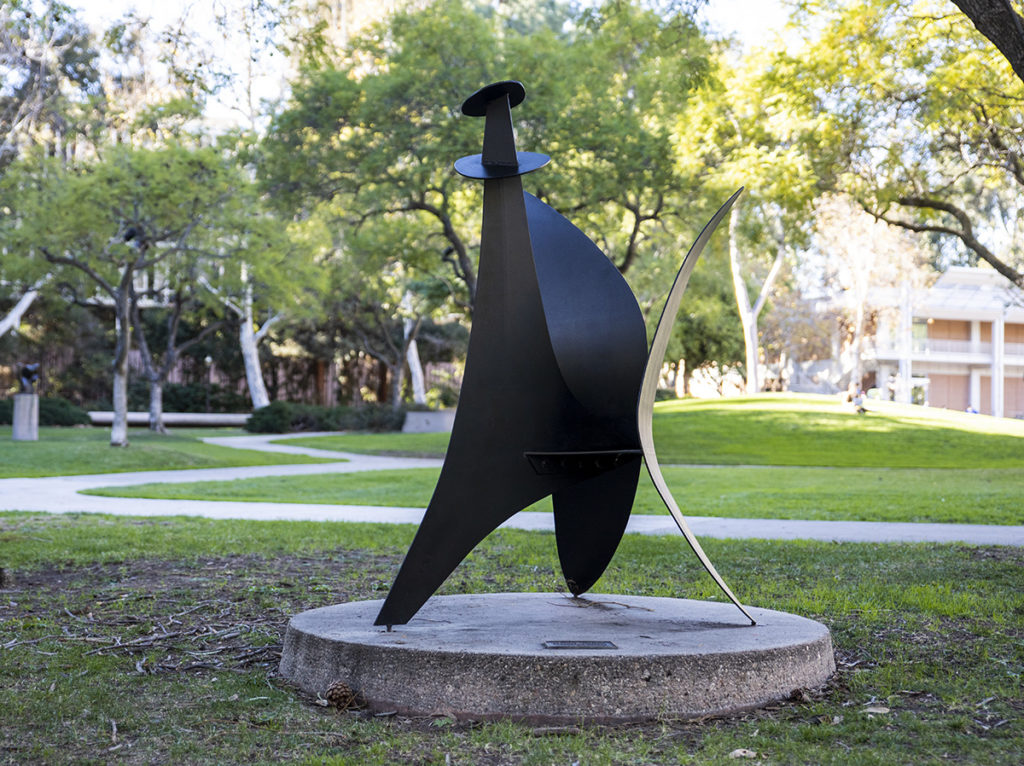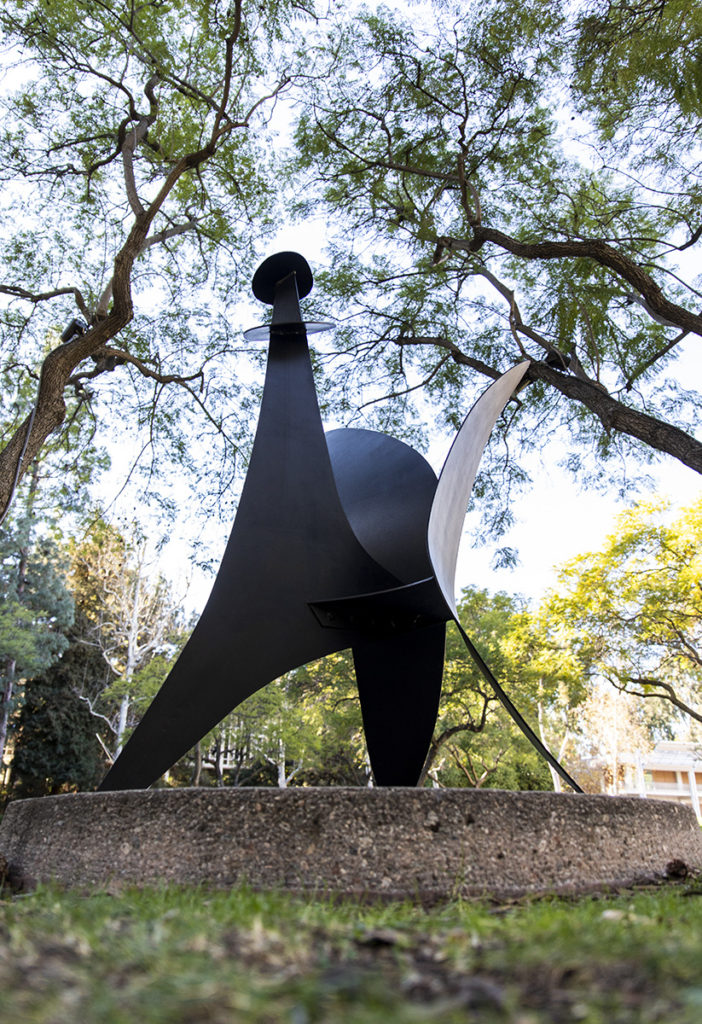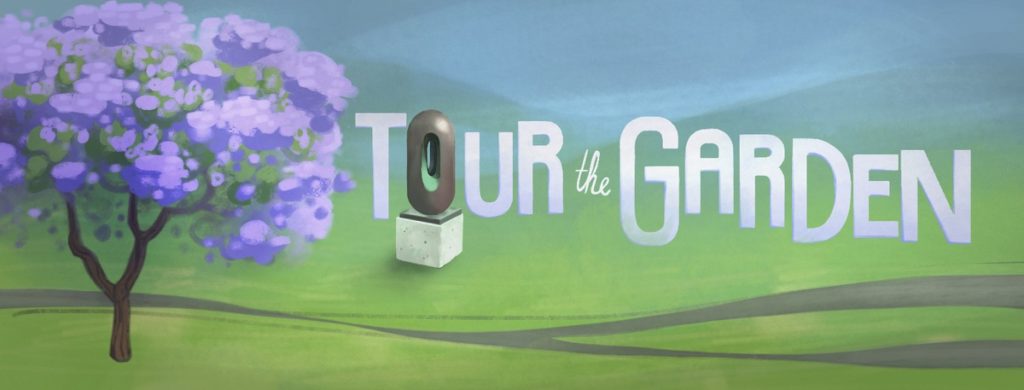Tour the Garden: Alexander Calder’s Button Flower epitomizes community focus of outdoor sculpture

(Katelyn Dang/Illustrations director)
By David Egan
Jan. 31, 2022 11:11 p.m.
As chancellor from 1960 to 1968, Franklin D. Murphy conceived of and curated UCLA’s Franklin D. Murphy Sculpture Garden. The bucolic hills and surrounding pathways, completed by architect Ralph Cornell in 1967, serve as a community hangout and the backdrop for some of the finest sculptures of the 20th century. Follow columnist David Egan as he explores the world of the sculpture garden and leads a tour of five artistic gems on North Campus.
The Franklin D. Murphy Sculpture Garden belongs both to Bruins and the people of Los Angeles.
It is a public art locale on the campus of a public university, with a parking lot right off of Sunset Boulevard. Glenn Wharton, a professor of art history and conservation of material culture who has worked with the city of Los Angeles to conserve outdoor sculpture, said those who are interested in outdoor sculpture are familiar with the garden. With artists such as Alexander Calder, whose sculpture Button Flower is in the garden, Wharton said nearly every artist is a major figure of 20th century art and the garden is regarded highly in the public art world, he said.
“When public art works at its best, people are engaged with it,” Wharton said. “If it’s contemplative, … people just go there and break out in tears, whereas other sculptures can make us laugh and some have kinetic elements – they move, they splash. Artistic objects in the environment can inspire us and make us alive.”

Aesthetically, the sculpture garden can be understood in contrast with the public art at UC San Diego, Wharton said. At UCSD, he said curators select an environment on campus and commission a contemporary artist to design a sculpture specific to that site. Both this program and the sculpture garden have their merits, Wharton said. While UCLA offers a singular location to appreciate a collection of works, UCSD’s curators allow viewers to discover varied and adventuresome works of art, he said.
The attention paid to public art differs from person to person, Wharton said. For example, he said, a traditional monument of a man on horseback may be irrelevant to people who pass it daily, while others may take more notice of the work and its subject. Whether it is the Spanish War Veterans Memorial outside the Los Angeles National Cemetery on Wilshire Boulevard or the modernist works in the garden, outdoor sculpture is a category of art in its own right, he said.
[Related: Tour the Garden: ‘The Walking Man’ embodies the sculpture garden’s historical, artistic context]
Outdoor sculpture is characterized by its exposure both to the elements and viewers, Wharton said. Corrosion of sculptures, he said, is accelerated by conditions such as temperature, humidity and agents of deterioration, including people who may graffiti or sit on works. The natural and architectural surroundings of works in the sculpture garden resonated with sculpture lecturer David Roy, a Los Angeles native who said he grew up visiting the garden.
“There’s no roof,” Roy said. “There’s an infinite sky. … The pieces aren’t constrained outside, and light does so much for sculpture. Seeing them on a cloudy day versus a bright sunny day, shadows that appear, … they would not happen inside. They have a lot more room to breathe outside.”
This is especially true for the 1959 Button Flower, which was sculpted by Calder, one of Roy’s favorite artists, he said. While Calder is known for his delicate mobiles, works that move mechanically or by air currents, Button Flower is categorized as one of his stabiles, a term coined by sculptor Jean Arp for Calder’s nonkinetic, stationary pieces. By the 1930s, Calder was making stabiles to be displayed as outdoor public art – sheet metal connected by bolts like Button Flower, with a raw construction Roy said he appreciates.
“You can say a lot as an artist with the way that you join material,” Roy said. “He took great pride in constructing or directing the way they were constructed, not trying to make it look like it just materialized. (It) was actually formed and built.”
[Related: UCLA student’s diverse art portfolio champions sensitivity, reminisces on memories]
Despite his use of metal, an industrial material, third-year art student Yesenia Terrones said Button Flower is a gentle form. The work does not immediately evoke a flower, she said, but certain shapes can be interpreted as leaves or petals. Wharton said Calder’s works are dynamic, and his stabiles look like they are in motion. Button Flower is athletic, Roy said, as it springs from the pedestal.

The athleticism of Button Flower is present when wind breaks through the sculpture, Terrones said, who has used metal in her own work. In the fall, she cut and welded a 5-foot metal frame for a sculpture and said she enjoyed how she could bend and maneuver the material. The sheet metal of Button Flower is also painted black. Wharton said this paint will deteriorate over time and it will eventually need to be stripped down and repainted.
“Fortunately the Calder Foundation is aware of this, and so they have people on staff who are available to conservators,” Wharton said. “They’re there to help guide conservation and to maintain his aesthetic intention for the works.”
For Terrones, accessibility to art is important – having artworks available in public, natural environments as opposed to only in museums. She said she finds value in the open space of the sculpture garden and appreciates seeing young children playing in the space. Roy, who first visited the garden at age 7, said he has seen the scale of works change in relation to his body over the years.
“It’s not like being in a gallery with a barrier or a guard who tells you you can’t get too close,” Roy said. “It’s a gathering spot, and I love that in art.”


